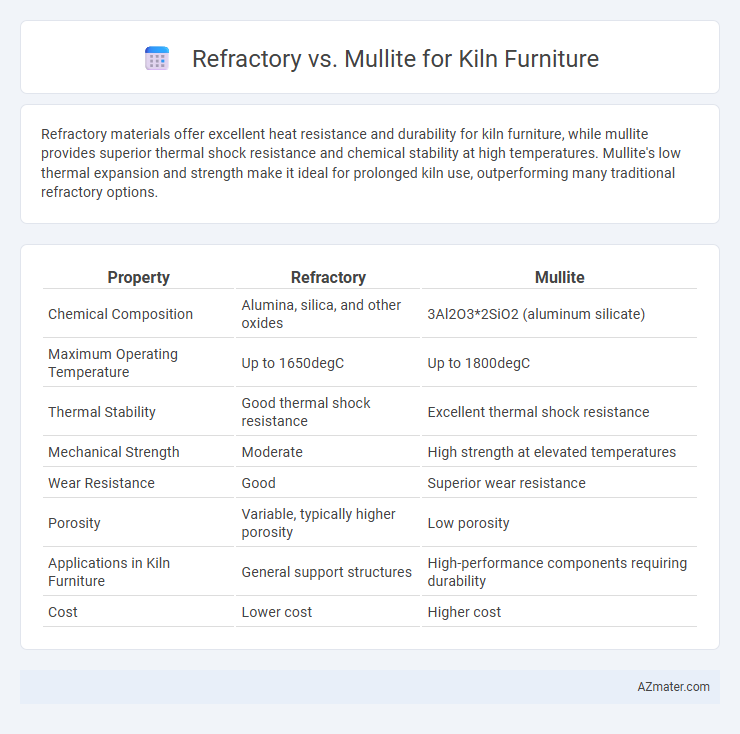Refractory materials offer excellent heat resistance and durability for kiln furniture, while mullite provides superior thermal shock resistance and chemical stability at high temperatures. Mullite's low thermal expansion and strength make it ideal for prolonged kiln use, outperforming many traditional refractory options.
Table of Comparison
| Property | Refractory | Mullite |
|---|---|---|
| Chemical Composition | Alumina, silica, and other oxides | 3Al2O3*2SiO2 (aluminum silicate) |
| Maximum Operating Temperature | Up to 1650degC | Up to 1800degC |
| Thermal Stability | Good thermal shock resistance | Excellent thermal shock resistance |
| Mechanical Strength | Moderate | High strength at elevated temperatures |
| Wear Resistance | Good | Superior wear resistance |
| Porosity | Variable, typically higher porosity | Low porosity |
| Applications in Kiln Furniture | General support structures | High-performance components requiring durability |
| Cost | Lower cost | Higher cost |
Introduction to Kiln Furniture: Refractory and Mullite
Kiln furniture is essential for supporting ceramic ware during high-temperature firing processes, requiring materials with exceptional thermal stability and resistance to thermal shock. Refractory materials, including dense fireclay and silica-based bricks, provide durability and heat resistance, while mullite, a crystalline aluminosilicate, offers superior mechanical strength and reduced thermal expansion. The choice between refractory and mullite kiln furniture depends on firing temperature, load requirements, and thermal cycling conditions, with mullite favored for high-performance, precision applications.
Understanding Refractory Materials
Refractory materials such as mullite are essential for kiln furniture due to their high thermal stability, mechanical strength, and resistance to thermal shock. Mullite, a key refractory ceramic, combines excellent corrosion resistance with low thermal expansion, making it ideal for long-lasting kiln shelves and supports in high-temperature applications. Understanding these properties enables optimal selection of kiln furniture, ensuring durability and efficient heat distribution in industrial firing processes.
What is Mullite? Composition and Properties
Mullite is a highly durable alumino-silicate mineral with the chemical composition 3Al2O3*2SiO2, commonly used in kiln furniture due to its excellent thermal stability and resistance to thermal shock. Its high melting point, low thermal expansion, and resistance to chemical corrosion make it ideal for supporting ceramics during high-temperature firing processes. Mullite's properties enable prolonged service life and consistent performance in harsh refractory environments.
Performance Comparison: Refractory vs Mullite
Refractory materials offer high thermal resistance and structural stability crucial for kiln furniture in high-temperature applications, while mullite provides superior thermal shock resistance and lower thermal conductivity, enhancing kiln efficiency. Mullite's microstructure enables better durability under cyclic heating, reducing crack formation compared to traditional refractory bricks. Performance comparison reveals that mullite kilns often exhibit longer service life and improved energy conservation due to their enhanced insulating properties.
Thermal Stability and Resistance
Mullite offers superior thermal stability with a high melting point around 1840degC, making it ideal for kiln furniture exposed to extreme temperatures and rapid thermal cycling. Refractory materials generally provide good heat resistance but can vary significantly in composition, often lacking the consistent thermal shock resistance and structural integrity that mullite inherently possesses. The alumina-silica composition of mullite ensures minimal thermal expansion and excellent resistance to thermal stress, extending kiln furniture lifespan in high-temperature industrial applications.
Mechanical Strength and Durability
Mullite exhibits high mechanical strength and excellent thermal shock resistance, making it ideal for kiln furniture subjected to rapid temperature changes. Refractory materials, typically composed of alumina and silica, provide robust durability but may vary in mechanical strength depending on composition and firing conditions. Mullite's superior crystalline structure ensures long-lasting performance and reduced deformation under high-temperature kiln operations.
Weight and Energy Efficiency Considerations
Mullite kiln furniture offers a lightweight alternative to traditional refractory materials, reducing the overall mass that must be heated during firing cycles, which enhances energy efficiency. Its high thermal stability and low thermal expansion minimize heat loss and thermal shock, leading to consistent kiln temperatures and lower fuel consumption. In contrast, heavier refractories retain more heat but require longer heating times, increasing energy costs and reducing operational efficiency.
Cost Analysis: Refractory vs Mullite Kiln Furniture
Mullite kiln furniture typically offers higher initial costs compared to general refractory materials but provides superior thermal stability and longer service life, reducing replacement frequency. Refractory materials may be more affordable upfront yet often face quicker degradation under extreme kiln conditions, leading to increased maintenance and downtime expenses. Evaluating total operational costs--including durability, thermal efficiency, and maintenance requirements--often reveals mullite as the more cost-effective option for high-performance kiln applications.
Applications and Suitability in Different Kiln Environments
Refractory materials and mullite play distinct roles in kiln furniture based on temperature resistance and chemical stability. Refractories, composed primarily of alumina and silica, are suitable for high-temperature industrial kilns used in metal forging and glass production due to their excellent thermal shock resistance. Mullite, with its superior creep resistance and thermal stability up to 1750degC, is preferred in ceramics and advanced materials kilns where dimensional stability and reduced contamination are critical.
Choosing the Right Material for Your Kiln Furniture
Selecting between refractory and mullite materials for kiln furniture depends on temperature resistance, thermal shock stability, and chemical durability. Refractory bricks offer high heat tolerance and durability at temperatures exceeding 1700degC, while mullite provides excellent thermal shock resistance and low thermal expansion, making it ideal for rapid heating and cooling cycles. Evaluating kiln operating conditions, including peak temperature and atmosphere, ensures optimal performance and longevity of your kiln furniture.

Infographic: Refractory vs Mullite for Kiln furniture
 azmater.com
azmater.com